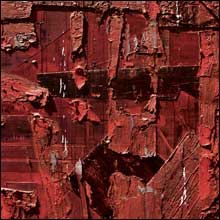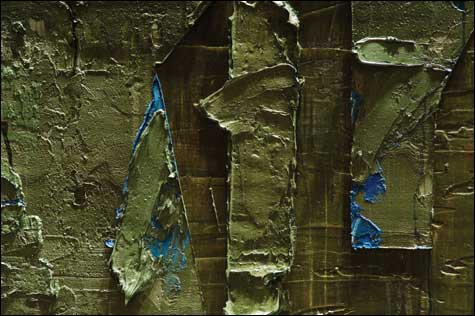
CHUNKY Ksiazek alternates between building up and archaeology. |
Wlodzimierz Ksiazek's exhibit of chunky, muscular abstract paintings at Rhode Island College's Bannister Gallery (600 Mount Pleasant Avenue, Providence, through March 30) is a dose of the old-time religion. The Pawtucket artist trenchantly continues to plumb Abstract Expressionism, which saw its heyday in the late 1940s and '50s, in these eight recent paintings. Most of them are nearly seven feet wide by about 5.5-feet high. The canvases are displayed like icons under dramatic raking spotlights in a darkened gallery to emphasize the textures of the surfaces.And what surfaces! A red 2010 canvas hums with its narrow range of hues — from crimson to deep blood red — applied in rectangular slabs of oil paint and wax, built up inches thick. You sense the artist pushing against the dense paint's inertia. Ksiazek drags the paint across in horizontal, vertical, and diagonal bands. And he gouges lines back into the crusty surfaces as he alternates between building up and archaeology. The big thrusts grab you from a cross the room, while up close you get drawn into coagulated, detailed textures, and tiny accenting touches like gray daubs and drips of black or white.
A 2008 painting has slabs of tarry black scraped atop yellow and root beer brown paint. It's thickly painted, but doesn't approach the high relief of the other canvases here, and so feels a bit more fleet footed.
Ksiazek's thick, spackle-like impasto can bring to mind the late- and mid-20th-century abstract painter Nicolas de Stael, who slathered thick slabs of paint across his canvases with palette knives. But the more immediate kinship is perhaps to Rhode Island painters Neal Walsh, AS220's gallery director who worked for a time as Ksiazek's studio assistant, and Lloyd Martin. Like their paintings, Ksiazek's art calls to mind the peeling paint, crumbling plaster, and rusting metal of dilapidated urban architecture—as filtered through geometric compositions. Ksiazek's paintings are built from a strictly limited vocabulary of vertical, horizontal, or diagonal strokes that can at times feel predictable. But Ksiazek's abstractions are painted with an earnestness little seen since Abstract Expressionism was king. And this can bring to mind those legendary soldiers left alone in some cave, who never got the message that the war is over, and remain determined to fight to the last man.

COILED ENERGY An untitled 2007 work. |
Abstract painting remains at the center of art discourse, but it's abstraction after 1960s Minimalism and Conceptualism, abstraction often focused on decoration or making conceptual points, abstraction infused with detachment and irony — as seen in Gerhard Richter, Julie Mehretu, Brice Marden, Mark Bradford, Ryan McGinness, or the "Collision" show at the RISD Museum (through June 19). Graffiti may be the sole area where painting has remained so earnest, so driven by the need to leave a mark.
Ksiazek's paintings seem more at home when consider-ed in the context of the Neo-Expressionist painting revival of the 1980s, when Ksiazek arrived in New York from his native Poland after Communist authorities there banned pro-democracy groups and imposed martial law. It can be tempting to read his painted marks as declarations of individual freedom. Ksiazek's paintings have the sort of ambition and gusto (and at times bombast) of '80s art stars like Anselm Kiefer and Julian Schnabel. In Ksiazek's best canvases, you sense coiled energy waiting to spring.